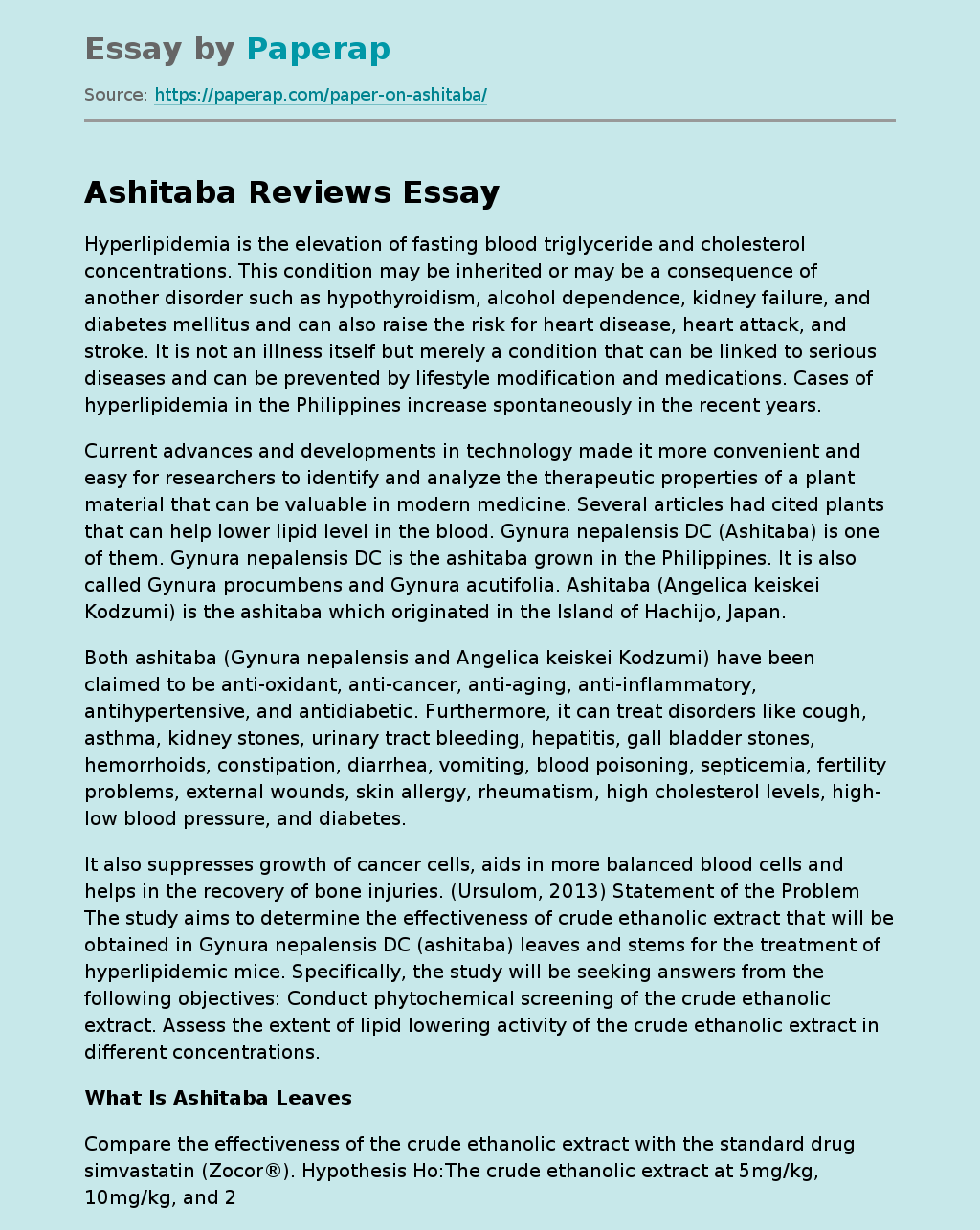Ashitaba Reviews What Is Ashitaba Leaves
Hyperlipidemia is the elevation of fasting blood triglyceride and cholesterol concentrations. This condition may be inherited or may be a consequence of another disorder such as hypothyroidism, alcohol dependence, kidney failure, and diabetes mellitus and can also raise the risk for heart disease, heart attack, and stroke. It is not an illness itself but merely a condition that can be linked to serious diseases and can be prevented by lifestyle modification and medications. Cases of hyperlipidemia in the Philippines increase spontaneously in the recent years.
Current advances and developments in technology made it more convenient and easy for researchers to identify and analyze the therapeutic properties of a plant material that can be valuable in modern medicine. Several articles had cited plants that can help lower lipid level in the blood. Gynura nepalensis DC (Ashitaba) is one of them. Gynura nepalensis DC is the ashitaba grown in the Philippines. It is also called Gynura procumbens and Gynura acutifolia. Ashitaba (Angelica keiskei Kodzumi) is the ashitaba which originated in the Island of Hachijo, Japan.
Both ashitaba (Gynura nepalensis and Angelica keiskei Kodzumi) have been claimed to be anti-oxidant, anti-cancer, anti-aging, anti-inflammatory, antihypertensive, and antidiabetic. Furthermore, it can treat disorders like cough, asthma, kidney stones, urinary tract bleeding, hepatitis, gall bladder stones, hemorrhoids, constipation, diarrhea, vomiting, blood poisoning, septicemia, fertility problems, external wounds, skin allergy, rheumatism, high cholesterol levels, high-low blood pressure, and diabetes.
It also suppresses growth of cancer cells, aids in more balanced blood cells and helps in the recovery of bone injuries.
(Ursulom, 2013) Statement of the Problem The study aims to determine the effectiveness of crude ethanolic extract that will be obtained in Gynura nepalensis DC (ashitaba) leaves and stems for the treatment of hyperlipidemic mice. Specifically, the study will be seeking answers from the following objectives: Conduct phytochemical screening of the crude ethanolic extract. Assess the extent of lipid lowering activity of the crude ethanolic extract in different concentrations.
Compare the effectiveness of the crude ethanolic extract with the standard drug simvastatin (Zocor®). Hypothesis Ho:The crude ethanolic extract at 5mg/kg, 10mg/kg, and 20mg/kg concentrations does not elicit lipid lowering activity when compared with the standard drug, Simvastatin (Zocor®). Ha:The crude ethanolic extract at 5mg/kg, 10mg/kg, and 20mg/kg concentrations elicit lipid lowering activity when compared with the standard drug, Simvastatin (Zocor®). Significance of the Study This study will be a useful tool in dealing with the concerns regarding the increasing prevalence of hyperlipidemia in the country.
The further determination of the active constituents and therapeutic properties of ashitaba plant can be beneficial to the medical field. This can also be a basis for a more advance analysis and identification of the pharmaceutical material that the plant bears. Since ashitaba plant is becoming well known in our country, this study can be a useful reference to the future researchers. It can encourage and motivate them to further expand the study into a wider point of view by not confining the study in the effects of the leaves and stems of the plant extract in the reduction of lipid level in mice.
Scope and Delimitations of the Study The study will be confined on the effects of ashitaba crude ethanolic extract in high lipid level in mice. Extracts are prepared in 3 different strengths – 5 mg/kg, 10mg/kg, and 20 mg/kg, for the comparison and evaluation of the effect in different concentrations. Lipid lowering activity will be performed; simvastatin (Zocor®) will serve as the positive control, the different concentrations as the experimental control, and the ethanolic base as the placebo. Along with this, complete blood count will be assessed to support the data of lipid lowering activity.
Ashitaba Reviews What Is Ashitaba Leaves. (2019, Dec 05). Retrieved from https://paperap.com/paper-on-ashitaba/

